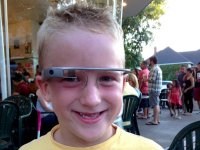Google Glass: Making Learning Visible with Wearable Technology
Your content has been saved!
Go to My Saved Content.I am an eye. I am a mechanical eye. I, a machine, am showing you a world, the likes of which only I can see. -- from Dziga Vertov's (1896 - 1954) "I Am Camera."
This September I watched anxiously as Dylan, my student in the Personal Projects class, lifted a jagged, ruby-colored shard of glass over the worktable while wearing computer-in-an-eyeglass technology known as Google Glass.
I asked was he recording. He nodded "Yes."
Dylan was about to smooth the edges of the ruby shard using a grinder for the stain-glass window he was making while recording the process using Glass. He is a responsible 17-year-old who had experience in the classroom studio, but after many years of teaching studio art, I can still get a little nervous about mixing young adults and new technology along with sharp objects.
"Make sure you direct the video towards your hands, but pay attention to what you're doing, please," I said. "Try to forget that you are recording and just make sure you don't lose a finger, ok?"
Dylan took my nagging in stride and again nodded in affirmation. He then gestured his head up and down to turn the device on and in a clear, distinct voice said, "Ok Glass, record a video." He brought the ruby shard towards the grinder as the machine whirred to life.
The recording process went smoothly and required little time to train Dylan in its use. After recording, a slight tap on the side of the device uploaded the video to a social network. The ease of use is partly why I am excited by pioneering Google Glass in the classroom, but I am most eager to explore the possibilities of using it for immersive, experiential learning and documentation used for reviewing and reflecting upon the student's work.
The Potential of Google Glass
A little more about the technology: Glass is a wearable computer, worn on the head like a pair of glasses and operated through voice commands and touch. The screen sits above the right eye within a transparent plastic enclosure. Also attached to this device are a camera for taking photos and video, and an earpiece that records your voice and transmits audio through the skull(!).
Additionally, the device allows for easy sharing of videos and photos via Google+, Tumblr, Facebook, and Twitter. The user can also send voice-to-text instant messages and emails, as well as send or receive phone calls. The device accesses the network via WiFi or by setting up a personal hotspot on Androids and iPhones. Glass is now in the beta stages of development, and Google sees this device as being the next step in personal mobile computing
Google Glass provides the educator a means for "making learning visible" (MLV), and can assist with the "observation and documentation in deepening and extending children's and adults' learning" that the Project Zero researches from Harvard and Reggio Emilia, who developed MLV, identified as key to effective teaching. The paradox of MLV is that documenting one's process within the workflow must itself be invisible if it is to be seamless and not "get in the way" of the actual work.
Because Google Glass frees the hands, is largely voice-activated and follows the natural gaze of the wearer, the student can go about the real work at hand and trust that the process is being documented.
Google Glass's ability allow for hands-free recording the point-of-view of the user is key to the MLV approach. Recording one's own work as it develops can be an awkward process. Students must stop what they are doing, pick up a camera and record the work as it develops. Often, when students are working with wet materials, on site, or with materials that require gloves, documentation becomes even more cumbersome; the flow and rhythm of student's work is disrupted, and progress is slowed.
A New Paradigm
In my classes we also discuss the problematic aspects of Glass: What does it mean when everyone and everywhere is visually documented and uploaded? In addition to the much-discussed topics of privacy and surveillance in current news, how might wearable devices like Glass affect our behavior and how we interact with people if, or when, such technology becomes the norm?
Finally, as educators we must ask whether the learning environment will become more experiential and open with devices like Glass? In a possible future, when learners become cameras, and learning -- with all its peaks and valleys -- becomes visible for all the world to see, will students (and perhaps teachers) close down, become inhibited, and afraid to take the necessary risks needed to reach students? Will we feel the need to script our day-to-day lives and don artificial personas like "actors" on "reality" TV?
Glass is a remarkable technology and definitely seems to point towards a new paradigm. Asking these questions now is of the utmost importance because that future might be sooner than we think.
What are your thoughts and ideas on using such technology as Google Glass in the classroom? Please share with us in the comment section.
